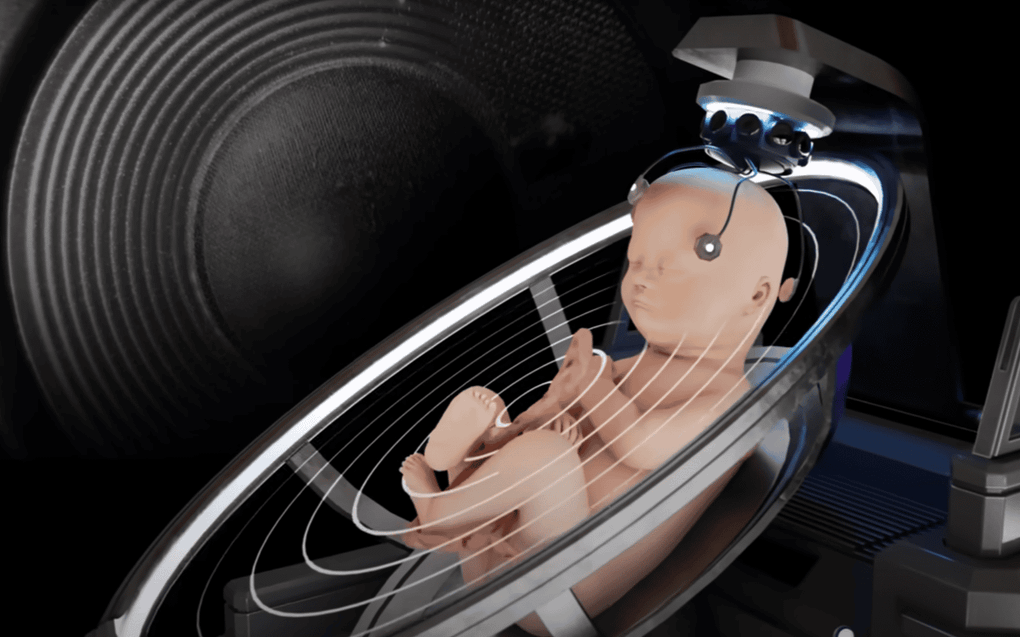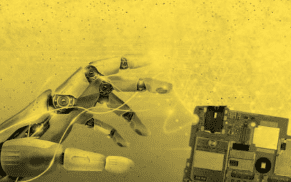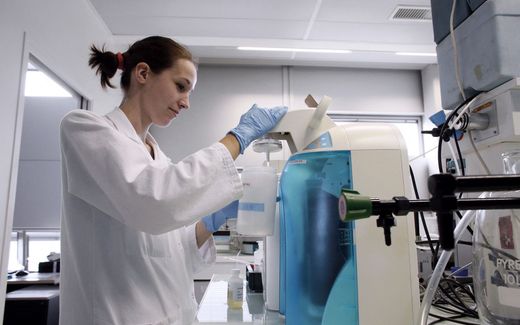What about growing human life outside the womb?
27-08-2025
Christian Life
Egbert Schuurman

Baby grown in an artificial womb. Still from YouTube
Christian Life
The technological world is on the threshold of being able to manipulate human procreation outside the mother’s womb, philosopher Egbert Schuurman writes in his essay The Genetic Engineering of Human Beings. How far can we ethically go?
Either directly or indirectly, recombinant DNA technology (which combines the DNA of different species to create new traits, ed.) also enables scientists to engineer human genetic information. Are there ethical limits to this power?
Charles Weissmann, a Swiss molecular biologist, once said that in the near future, every person will be able to apprise himself of the nature, structure, and function of his own genes. A gene is the smallest unit of hereditary information. The recombinant DNA enables scientists to map our hereditary information. That information consists of roughly one hundred thousand genes, ten thousand of which have thus far been researched. Before long, it is thought, scientists will completely understand our total genetic being. Aided by the computer, such “gene mapping” will become a manageable research procedure.
Such research could easily lead to a higher rate of abortions
If such gene profiles are not protected, they can easily be abused, as, for example, through discrimination in the workplace and by prejudicial conditions made by insurance policies if the gene profile shows that the insured poses a high risk to the company.
Naturally, such ethical questions become even more crucial when a reading of parents’ gene profiles in combination with the prenatal investigation of the fetus's gene profile shows that the child has an “unfavourable” gene structure. Such research could easily lead to a higher rate of abortions.
Complex genetic changes
Going even further, Weissmann explains: “Deep down, I know that at some point in the future –I speak of decades– it will be possible to bring about complex genetic changes in man. Then we will have to confront head-on the associated ethical problems.”
We may not be in such a situation yet, but we are on the threshold of an age in which we will be able to manipulate procreation outside the mother’s womb. Parents availing themselves of homologous insemination can now be helped in the conception of their own child. Through heterologous insemination, it is possible to conceive a child whose father remains anonymous.
The possibilities of the test-tube technique will increase to the point that fertilized ova of preselected parents can be implanted in other women. With the aid of test-tube technology, it will be possible not only to signal hereditary defects in advance, but also to “construct” a super-baby with the most favourable genetic structure. Thus, the recombinant DNA technology will be applied by way of the test tube to the human embryo.
The technique of cloning was proven successful in mice and frogs but has not yet been applied to human beings
Clearly, we are here presented with significant ethical questions. Some people rightly warn that these techniques have already claimed the lives of many fetuses that were not considered suitable for implantation, or that they were simply superfluous. Others maintain that the sole criterion for application of this technology should be the quality, not the viability, of individual life.
The available literature that advocates this so-called high quality of life also promotes the “creation” of large numbers of such high-quality individuals. This is known as cloning. The technique of cloning was proven successful in mice and frogs but has not yet been applied to human beings. But even if it were possible to apply it to human beings, would it be permissible?
Prohibition
I wish to discuss yet another experiment. In a certain area of research, scientists have tried to fertilize the ovum of a hamster with the sperm of a male human being. The result was a hybrid, a life-form somewhere between that of a human being and a hamster, that could develop to the stage of a few undifferentiated cells.
Generally, experimentation with life forms between human beings and animals is not tolerated. Non-Christians appeal to the norm of human worth or humanity. Many non-Christians use this norm to argue for the prohibition of experiments that could lead to further experiments involving different life forms.
In borderline cases, however, objections are less strenuous. In November 1982, the British medical research council established a number of guidelines for such experiments. One such guideline would halt fertility tests that could lead to "the human-hamster hybrid system" before cell division started.
Fertility
Whereas these tests already signal the beginning of hybridization, they, too, should be rejected. This is true especially since these tests could signal the beginning of genetic engineering of those varied cells which include the hereditary information of the human. By way of such tests, the technology of recombining genes could easily be deflected into new and, in my estimation, illegitimate avenues. In the meantime, scientists should look for more ethical types of experiments to test the fertility of the ovum.
I do not expect the resistance to such experiments to stiffen. Rather, because of the positive potential of test-tube techniques, the experiments are likely to increase. One reason for this laissez-faire attitude can be found in the widely accepted legalization of abortion. To a large degree, the legalization of abortion has promoted experimentation with the human genetic structure. The American ban on federal funding for the transplantation of tissue from aborted fetuses into humans has recently been lifted. Hard and fast rules governing these experiments can no longer be established.
Recent research journals claim that experiments with aborted fetuses are necessary to test new medicines that can be of benefit to humankind
Similarly, nothing is done about experimenting with aborted fetuses kept alive for research purposes. Recent research journals claim that experiments with aborted fetuses are necessary to test new medicines that can be of benefit to humankind, for example, in the struggle against Parkinson's disease.
Machines
a. Objections. My objections against possible genetic engineering of fertilized ova in vitro and against manipulating forms of life between human beings and animals, including life-forms in their initial stages, are based on my rejecting the current view of humans that has long been subliminally accepted, but that has now found its way into the public domain through labs and hospitals.
Increasingly, people today are accepting and promoting a view of humanity that is thoroughly materialistic, a view inspired by the natural sciences and modem technology. It is said that human beings are machines, albeit very complicated ones, or a complex physical-chemical substance or, more recently still, an information programming system of complex DNA molecules.
When one's view of human beings is tied to a specific dominant area of science, that particular view of human beings becomes the dominant one. In this way, specific, abstract views of human beings are absolutized. Their totality and unity be comes subservient to the theories of science and technology. The end result is a reductionist view of the human race. Having fallen this far, people can easily fall prey to the manipulation of other theories.
Worth
This reduced view of human beings was originally limited to scientific and philosophic circles. However, when the materialistic world-and-life view gained ground and the Christian world-and-life view went into retreat, this reductionist view became commonplace.
This secularizing of culture contributed to the fact that this thinking about human beings as purely material beings could be applied as a theory more and more. Humans were dehumanized and compared to a thing. Fortunately, quite a few humanists also protested this dehumanization since it challenges our humanity and human worth.
Through the potentials promised by genetic engineering and the test-tube technique, the materialistic view has reached its zenith.
The materialistic view did not first become evident in genetic engineering. The modern way of using human resources in the labor process, as well as attempts to legalize abortion, have been clear evidence of this reduced view of human beings. Through the potentials promised by genetic engineering and the test-tube technique, the materialistic view has reached its zenith.
Sickness
The Christian sees the individual, though corrupted and defaced, as the created image of God. God's love and care continually reach out to the individual. Therefore, we must love every one of our fellow human beings. Out of this love we can use scientific-technological possibilities to combat sickness and relieve suffering, as is done in medical science. But the Christian's view of human beings is based on the inviolability and integrity of every individual, as well as on the realization that we can only moderate human suffering and can never entirely repair the effects of his corruption. Viewed from the perspective of creation and fall, the origin of this corruption lies in human beings wilfully breaking their communion with God. This religious failure cannot be remedied by science and technology.
As indicated, the materialistic view of human beings does not accept the inviolability of human life. Instead, it focuses on the quality of life. The purpose of technology is to obtain the highest possible quality. In this view, our broken life may, in theory, appear to have been repaired by science and technology. In a real sense, genetic engineering then also has to guarantee the quality of its product. Needless to say, a poor product is not acceptable and must therefore be destroyed.
Craft method
b. The Test-Tube Baby. Rejection of the test-tube technology invariably brings the counterargument that the method is ideal for helping childless parents who have found the more natural avenues of conception closed to them. This is a noteworthy argument, provided the method of test-cube technology is not used unless absolutely necessary.
Yet closer inspection and a thorough acquaintance with the literature available on the subject will show that more is involved here than may at first appear. The many questions and problems of test tube technology can be avoided by helping prospective parents in other ways.
I have in mind the Craft method, which involves the removal of ova from blocked fallopian tubes and their implantation into the womb, together with male sperm, before fertilization takes place.
This method can be applied on a large scale and is socially more acceptable because its costs are much smaller, and thus, its opportunities accrue not only to a small, privileged elite.
Embryo
From an ethical point of view, I believe this method to be acceptable, for it does not allow for unjustified experiments and, secondly, the womb is where conception takes place and the embryo grows.
In the event of failure, any one of the remaining embryos will take the reject's place
By contrast, if fertilization takes place in the lab, it is not possible to control the number and types of experiments conducted on ova. It may also mark the beginning of the recombination or manipulation of genes. As far as I know, no efforts have been made thus far to try to change human genetic information. However, the laboratory method of artificial insemination does require multiple ova, only one of which will ultimately be re-implanted. In the event of failure, any one of the remaining embryos will take the reject's place.
Moreover, the criteria of artificial insemination demand that the ultimate product meets certain standards of excellence. Thus, the test-tube technology itself must be able to guarantee the quality of life. This, in turn, means that selections must be made between products that are likely to be successful and those that are not, or perhaps less so. Is it up to us, however, to make such judgments and take decisive action? This can happen only if the individual is no longer seen as unique in the eyes of God and when human beings arbitrarily decide which human life meets current standards and which does not.
There is another equally important argument. From a number of publications, it appears that this technology is used to conduct uncontrolled scientific experiments on test-tube embryos. Through these experiments, researchers are encouraged to explore all kinds of new avenues. Any technology that offers such unlimited and uncontrolled opportunities to researchers must surely be rejected.
Genetic defects
I previously mentioned that the test-tube technology has thus far not been used to bring about planned changes in human genetic information. However, this has been done with animals. Rat genes pertaining to the rat's growth hormones have been implanted in the embryos of mice. The mice so manipulated turned out to be super-mice, whose offspring showed evidence of the ca. lier gene transplant.
The successful experiments conducted on animals open the way to similar experiments with the genetic information of human beings. The very possibility requires us to deal with it at this time. Repairing genetic defects, infusing into people specific characteristics, such as greater intelligence, no longer belongs to the area of science fiction.
What happens when a genetic experiment fails?
However, before this can be put into practice, many experiments will have to be conducted, and this necessary experimenting with human beings cannot be justified. In a recent article, Professor H.J.J. Leenen of the University of Amsterdam raised a number of questions to which there are no unambiguous answers: What possible dislocations can the change of genetic information have on an organism? What unknown characteristics will be brought on by the new combination of genes? What is the effect of reinforcing a particular characteristic in terms of the overall balance in an organism? What happens when a genetic experiment fails?
Suffering and evil
My conclusion is that test-tube technology will surrender the total human genetic structure to scientistic and technicistic models. For that reason, it is not at all certain whether the high expectations will materialize. Quite possibly, the opposite could be true.
As a matter of fact, the opposite is certain. Materialistic human beings now think they can offset the ill effects of what was a religious failure, the fall into sin, by means of science and technology. Since human beings, without God, are no longer capable of bearing or absorbing the effects of sin, such as suffering and evil, they seek to redeem themselves, but in the process invite more suffering and evil upon themselves.
Does this mean that all genetic engineering of human beings must be rejected? No, not if the supremacy of science and technology is brought low in order to be turned to service. Only then will there be an end to the scientistic and technicistic approach to humanity. Only then can we enlarge on the perspective of a normative development for science and technology. I can appreciate genetic engineering if it is applied to remedying certain hereditary deficiencies and diseases, but only if the approach zeroes in on limited genetic therapy on the organic level rather than on a general treatment of the total genetic structure. In any case, all the ethical rules of medical experiments must be strictly observed.
Conception
c. Conclusion. Objections have been raised against the use of the term test-tube baby, and rightly so, because the baby does not come from a test tube. But I hope that the term “test tube” continues to serve as a reminder that conception takes place in a laboratory. Temporarily, the pregnancy is interrupted. That brief time is filled with human technologies, for which the recipients will want some form of guarantee ensuring the quality of the “product”. Right from the beginning, the materialistic process has degraded human beings to things to be manipulated.
Even the intent of this technology –although there may be no plans to experiment or keep back some spare embryos– must be rejected because of its many unforeseeable consequences. This is all the more so since research into the Craft method has not come to a dead-end.
I would hope that our ethics will not change when it comes to conducting experiments on children or the mentally impaired.
Craft’s alternative method, however, does not get the attention it deserves, primarily because it precludes any tinkering with the embryo. Generally, support for experimentation comes from secularized religion, the atheistic religion of Western man, which was developed from the Renaissance, through rationalism and the Enlightenment, to our increasingly scientistic and technicistic culture. The technology of the test-tube baby and the many possible experiments associated with it show clearly the post-humanity of our technicistic age.
Someone might possibly object that because ethics is always undergoing change, I should be more careful with my dismissal. That is often true, especially in a secularized culture where Christian norms and values, long cast in stone, have suddenly begun to shift like sand. However, I would hope that our ethics will not change when it comes to conducting experiments on children or the mentally impaired. Why should our ethical position change with respect to embryos? My position makes clear where the boundaries are, and even then, much reflection is needed to prevent responsible technologies from degenerating into acts of unspeakable evil.
Symptoms
Without a doubt, the problems surrounding modern science and technology are becoming more menacing. The responsibility of scientists and researchers, together with all those people involved in various ways in technological development, is becoming steadily heavier and more difficult. But, as I pointed out earlier, that responsibility must also have a different orientation than the current one.
We cannot continue to dwell on symptoms, but must search out the causes of the various critical traits. We cannot limit ourselves to partial problems, but must attack the many challenges with an integrated strategy. The combination of science, technology, and secularization encourages solutions that may provide some short-term gains but will bring agony in the long ran.
If we elect to solve the problems caused by science and technology by applying more scientific and technological solutions, the process of escalating technicism will only be reinforced. If, furthermore, science and technology become political instruments, the result will be a technocracy in which we, though still making our contributions, will become the slaves of anonymous, pseudo-independent forces.
I have pointed out in various ways the need to approach the question of responsibility differently from the way that is currently fashionable. In many respects, we will once again have to pose authentic questions, such as ones about the origin and meaning of things, about the coherence and diversity of everything, and especially questions about normativity for all of creation.
Challenge
Christianity must accept this challenge. This means that the materialistic inclination, which in its diverse forms has reduced and sealed up a view of the world as a world without God, must make way for a profound, resolute, spiritual conviction.
This conviction will attest to our dependence on Christ, our Redeemer, from sin, guilt, and evil. It will also confess to our relationship with God, the Creator of the whole of reality.
This renewal will offer a new direction to scientific and technological opportunities as it rejects autonomous, atheistic, and materialistic world-and-life views. In the latter, man remains the measure of all things, while in the Christian view, the law of God, as manifestation of God's will and summed up in the two love commandments, continues to provide direction to all things. Through it, we can be liberated from the menacing super-force of science and technology.
This essay is part of the book Technology and Christianity by Prof. Dr. Egbert Schuurman published by Wordbridge Publishing
Related Articles











